
- Great Britain Rare
- Denomination
- Era
- 1700s (4)
- 1800s (14)
- 1816-1913 (22)
- 1900s (4)
- 1914-1945 (126)
- 1920s (5)
- 1945-present (73)
- 1970s (3)
- 2000s (7)
- Elizabeth Ii (3)
- George V (5)
- George V (1910-1936) (32)
- Milled (1816-1837) (7)
- Pre - 1700s (4)
- Pre-1952 (2)
- Pre-wwii (pre-1942) (2)
- Queen Victoria (4)
- Victoria (8)
- Victoria (1837-1901) (89)
- Victoria (1840-1901) (16)
- ... (3705)
- Grade
- Place Of Origin
- Quality
- Year Of Issue
RARE Antique British Navy WWI Trench Art HMS QUEEN MARY Carpenter Box WOW

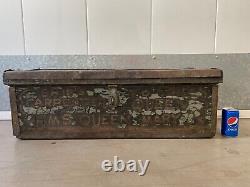

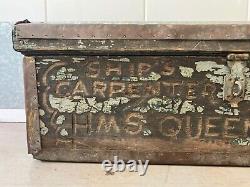

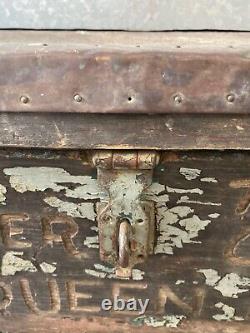
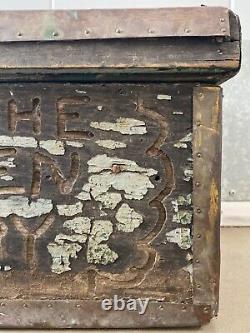
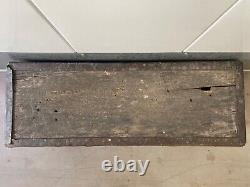
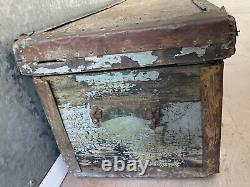





This is a historically significant and RARE Important Antique British Navy WWI Trench Art HMS QUEEN MARY Carpenter Box, belonging to the HMS Queen Mary's head carpenter, Frederick Norman Barber or his crew, and dating to the 1910's. This box may have even been used by the head carpenter during the construction of the Queen Mary, years prior to its actual first voyage.
Approximately 10 inches tall x 30 inches wide x 10 1/4 inches deep. Good - Fair condition for 100+ years of work use, exposure to salty ocean air, and age storage please see photos. The lid is detached from the box, due to broken and missing hinges.
I have not made any attempts to restore this piece or fix the hinges to respect its historical integrity. Acquired from an old collection in Los Angeles, California. You will not see anything like this artifact anywhere, and it is truly a rare and one-of-a-kind piece of British WWI Naval history.This artifact would eagerly be displayed at the National Museum of the Royal Navy in Portsmouth. Please check out my other listings for more wonderful and unique artworks! About the HMS Queen Mary. Was a British battlecruiser that entered service in 1913.
The last battlecruiser completed for the Royal Navy prior to World War I. It saw action during the early engagements of the conflict. Sailing with the 1st Battlecruiser Squadron. Was lost at the Battle of Jutland in May 1916. Palmers Shipbuilding and Iron Company.
Sunk at the Battle of Jutland, May 31, 1916. Parsons direct-drive steam turbines, 42 Yarrow boilers, 4 x propellers. 6,460 miles at 10 knots.
4 × 2: BL 13.5-inch Mk V guns. 16 × 1: BL 4-inch Mk VII guns.
2 × 1: 21-inch Mk II submerged torpedo tubes. On October 21, 1904, Admiral John "Jackie" Fisher became First Sea Lord at the behest of King Edward VII. Tasked with reducing expenditures and modernizing the Royal Navy, he also began advocating for "all big gun" battleships. Moving forward with this initiative, Fisher had the revolutionary HMS Dreadnought built two years later. Instantly made all existing battleships obsolete.
Fisher next desired to support this class of battleship with a new type of cruiser that sacrificed armor for speed. Dubbed battlecruisers, the first of this new class, HMS. Was laid down in April 1906. It was Fisher's vision that battlecruisers would conduct reconnaissance, support the battle fleet, protect commerce, and pursue a defeated enemy. Over the next eight years, several battlecruisers were constructed by both the Royal Navy and the German Kaiserliche Marine. Ordered as part of the 1910-11 Naval Program along with four. A follow-on to the earlier. Armed with eight 13.5 in.Guns in four twin turrets, the battlecruiser also carried sixteen 4 in. S armor scheme varied little from the.
S and was thickest amidships. This thinned moving towards the bow and stern. An upper belt of reached a thickness of 6 over the same length. Armor for the turrets consisted of 9" on the front and sides and varied from 2.5" to 3.25 on the roofs. The battlecruiser's conning tower was protected by 10" on the sides and 3" on the roof.
S armored citadel was closed off by 4 transverse bulkheads. Power for the new design came from two paired sets of Parsons direct-drive turbines which turned four propellers.
While the outboard propellers were turned by high-pressure turbines, the inner propellers were turned by low-pressure turbines. Which had positioned the officers' quarters near their action stations amidships. As a result, it was it the first British battlecruiser to possess a stern walk. Laid down on March 6, 1911, at Palmer Shipbuilding and Iron Company in Jarrow, the new battlecruiser was named for King George V's wife, Mary of Teck.
Work progressed over the next year and. Slid down the ways on March 20, 1912, with Lady Alexandrina Vane-Tempest serving as the Queen's representative. Initial work on the battlecruiser ended in May 1913 and sea trials were conducted through June. Utilized more powerful turbines than earlier battlecruisers, it only barely exceeded its design speed of 28 knots. Returning to the yard for final alterations. Came under the command of Captain Reginald Hall. Assigned to Vice Admiral David Beatty's 1st Battlecruiser Squadron. Commenced operations in the North Sea. The following spring saw the battlecruiser make a port call at Brest before a voyage to Russia in June. In August, with Britain's entry into World War I. And its consorts prepared for combat. On August 28, 1914, the 1st Battlecruiser Squadron sortied in support of a raid on the German coast by British light cruisers and destroyers. In the early fighting during the Battle of Heligoland Bight, British forces had difficulty disengaging and the light cruiser HMS.Under fire from the light cruisers SMS. It called for aid from Beatty. Steaming to the rescue, his battlecruisers, including. And the light cruiser SMS.
Before covering the British withdrawal. Took part in Beatty's attempt to ambush German naval forces as they conducted a raid on Scarborough, Hartlepool, and Whitby.
In a confusing series of events, Beatty failed to bring the Germans to battle and they successfully escaped back the Jade Estuary. Received a new fire control system before entering the yard for a refit the following month.As a result, it was not with Beatty for the Battle of Dogger Bank on January 24. Returning to duty in February. Continued to operate with the 1st Battlecruiser Squadron through 1915 and into 1916. In May, British naval intelligence learned that the German High Seas Fleet had left port. Steaming in advance of Admiral Sir John Jellicoe's Grand Fleet, Beatty's battlecruisers, supported by the battleships of the 5th Battle Squadron, collided with Vice Admiral Franz Hipper's battlecruisers in the opening phases of the Battle of Jutland.
As Beatty closed the range. Scored two hits on its opponent and disabled one of.The smoke from this obscured HMS. To shift its fire to. Detonating one or both of its forward magazines. The resulting explosion broke the battlecruiser in half near its foremast.
May have hit further aft. S crew, 1,266 were lost while only twenty were rescued. Though Jutland resulted in a strategic victory for the British, it saw two battlecruisers, HMS. Lost with nearly all hands. This item is in the category "Collectibles\Militaria\WW I (1914-18)\Original Period Items\Great Britain\Other British WWI Orig. The seller is "willsusa_utzeqm" and is located in this country: US. This item can be shipped to United States.- Region of Origin: Great Britain
- Modified Item: No
- Country/Region of Manufacture: United Kingdom
- Theme: Militaria
- Original/Reproduction: Original
- Conflict: WW I (1914-18)

